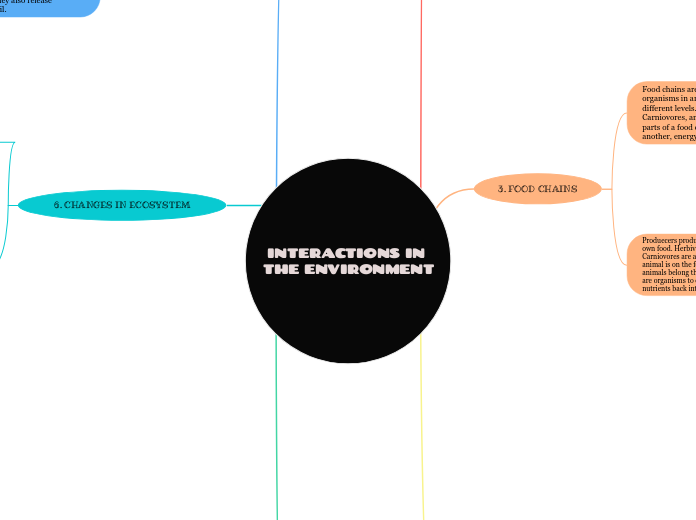INTERACTIONS IN THE ENVIRONMENT
2. SYMBIOSIS
Symbiosis is the relationshio between two organisms in a commuinity. There are three tyes of symbiosis. Parasitism is a relationship where it benefits one of the sides while the other one isn't being benefited from this relationship. Another type is commensalism. Its when one is benefited but the other isn't harmed. Lastly, mutalism is when both sides are benefitted.
Parasitism is when one side is benefitted, but the other is not. For example, fleas and a dog. The fleas are being benefitted while the dog is not being benefited .
Commensalism is when one is benefited while the other one isn't benefitted, but they are not being harmed For example, a bird living on a tree.
Mutaualism is when both sides are being benefitted. For example, a bee and a flower. Both sides are being benefitted. The bee recieves pollun and the flower gets pollunated.
3. FOOD CHAINS
Food chains are the feeding relationships of organisms in an ecosystem. Food chains have different levels. Producers, Herbivores, Carniovores, and Decomposers. They are all parts of a food chain. When one organism eat another, energy gets passed to another level.
Produecers produce energy from the sun to make their own food. Herbivores eat plants to get energy. Carniovores are animls that eat meat. The higher the animal is on the food chain, they have the ability to eat animals belong them in the food chain. Decomposers are organisms to eat off of decaying matter and put nutrients back into the soil.
1. Decomposers
2. Carnivores
3. Herbivores
4. Producers
4. FOOD WEBS
Food webs are a complex network of food chains in an ecosystem. Food webs can overlap when two animals eat the same type of food. Food webs link many chains together which contains many herbivores, carnivores, and omivores. Organisms are dependant on each other within an ecosystem
One animal can be apart of two food chains. A food web have many different tyoes of organisms and links many chains together for example, herbivores, decomposers, carnivores, etc.
1. ECOSYSTEMS
Commuinty of animals and plants interacting in an enviroment. In an ecosystem there are both biotic (Living things) and abiotic (Non living things) organisms. Biotic and Abiotic factors help each other live and save the ecosystem
In an ecosystem, living things are sorted into groups. Producers, Composers, and Decomposers. They each play a different role that all help the ecosystem. For example, plants are producers. They make food fron sunlight and also provide oxygen for the other organisms. Animals are consumers and they eat off of plants and take their energy. Decomposers are organisms that eat decaying plants. They help the exosystem by eating the dead plants. They also release nutrients back into the soil.
6. CHANGES IN ECOSYSTEM
Ecosystems are constantly chaning in small ways. Succiesion is when the gradual growth of new organisms in an ecosystems. Humans and organisms both change the ecosystem in many small ways.
There are three types of successtion in an ecosystem. Succesion cannot be noticed right away since its slowly changing. Primary succestions changes that creates a new ecosystem where one did not exist before. Secondary succession is when ecosystem has been wiped out and begins to regenerate itsef and start anew. Secondary succession is usually faster than primary successtion. Secondary succession can also help the ecyostsems fight back to any challenges.
5. BIOMES
Biomes are a major ecyostsem. They are where animals or organisms live. The six biomes on planet Earch, they are Taiga, Tundrea, Deciduous forest, tropical rainforests, deserts and grasslands. The main difference between biomes is climate.
Deciduous forest is the only biome that has four seasons. Trees here bloom in spring and looses their leaves in fall. Foxes and bobcats live in this forest.
Tropical rainfoests climates are warm and humid year round. Animals like monkies and leopards live in the rainforests
The Taiga is the biggest biome of all. It has two seasons. Cold winters and warm summers. It is mainly found in Russia and Canada. Mooses tend to live there.
Tundra is veey cold and no trees can grow. Polar bears and reindeers all live in the Tundra.
Desserts are very dry and hot. They recieve less than ten inches of water a year. Catcuses and beetles live in the desserts
The grass lands are found in the US, Africa, Asia and South America. Gazillas and zebras also live in the grasslands. Grains like corn and wheat can be grown here.
